Overview
A spinal infection happens when bacteria, fungi, or other germs affect the bones, discs, or soft tissues of the spine. Among all spinal infections, tuberculosis (TB) of the spine—also known as Pott’s disease—is the most common in countries like India.
TB spine usually affects the thoracic (mid-back) or lumbar (lower back) regions. It can cause pain, stiffness, and in advanced cases, deformity or nerve-related problems.
The encouraging news is that with early diagnosis and proper treatment, most patients recover fully, and surgery is needed only in selected cases.
Causes
Spinal infections can develop due to:
- Tuberculosis (TB): Spread from the lungs or other organs to the spine through blood.
- Bacterial infections (pyogenic): From bloodstream infections, urinary infections, or after spine surgery.
- Fungal infections: Rare, usually in people with weak immunity.
Spinal TB accounts for nearly 50% of all bone and joint TB cases
.
Signs and Symptoms
Patients may experience:
- Persistent back pain – Gradually increasing, not relieved by rest.
- Stiffness and difficulty moving the spine.
- Fever, night sweats, or weight loss (especially in TB).
- Neurological symptoms – Numbness, tingling, weakness in the legs if nerves are compressed.
- Visible spinal deformity (kyphosis or hump) in advanced TB.
Severe untreated cases can lead to paralysis, but this is preventable with timely care.
Treatment Options
Conservative (Non-surgical) Treatment – First Line
- Anti-tubercular therapy (ATT): Standard TB medicines for 9–12 months remain the cornerstone of TB spine treatment.
- Medications for pain and inflammation.
- Bracing: A supportive brace may be advised in some cases to protect the spine.
- Nutrition & rest: Balanced diet and avoiding heavy strain aid recovery.
Studies show that over 85–90% of patients with TB spine recover with medications alone.
Surgical Treatment – When Needed
Surgery may be recommended if:
- There is severe spinal cord compression causing weakness or paralysis.
- Spinal deformity is progressing.
- There is large abscess formation not responding to medicines.
- Pain remains severe despite proper medical treatment.
Common surgical options:
- Decompression surgery: Removing infected tissue or abscess pressing on nerves.
- Stabilization (spinal fixation): Using rods and screws to correct deformity or instability.
Surgical outcomes are excellent, with 70–90% of patients regaining good function and mobility.
Frequently Asked Questions
Yes. With proper TB medicines and timely care, most patients make a complete recovery.
No. The majority of patients improve with medications alone. Surgery is required only if there are complications like nerve pressure, severe deformity, or non-healing abscess.
Anti-tubercular therapy usually continues for 9–12 months, depending on the patient’s response and doctor’s advice.
If untreated, TB spine can sometimes compress the spinal cord and cause weakness. But with early diagnosis and treatment, this can usually be prevented or reversed.
Take medicines regularly, avoid heavy lifting, maintain good nutrition, and follow up regularly with your doctor.
Book Now
Consult our experts today

